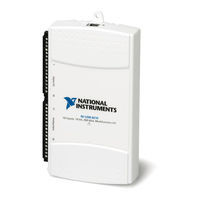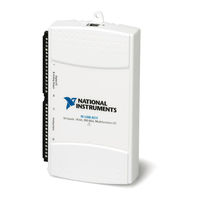National Instruments NI USB-621 Series Manuals
Manuals and User Guides for National Instruments NI USB-621 Series. We have 2 National Instruments NI USB-621 Series manuals available for free PDF download: User Manual
National Instruments NI USB-621 Series User Manual (185 pages)
DAQ M Series Bus-Powered M Series USB Devices
Brand: National Instruments
|
Category: I/O Systems
|
Size: 4 MB
Table of Contents
-
-
Conventions12
-
-
-
-
AO Range73
-
-
-
-
-
-
-
-
-
-
Sample Clock125
-
Counter Filters126
-
Prescaling127
-
-
-
-
80 Mhz Timebase135
-
100 Khz Timebase135
-
-
Appendix B
141 -
Appendix C
141-
Figure141
-
USB-6210 Pinout141
-
-
Appendix A
143
Advertisement
National Instruments NI USB-621 Series User Manual (178 pages)
Bus-Powered M Series USB Devices
Brand: National Instruments
|
Category: Computer Hardware
|
Size: 4 MB
Table of Contents
-
-
Conventions13
-
-
Appendix B
32 -
Appendix C
32-
Figure32
-
-
-
-
-
-
AO Range69
-
-
-
-
-
-
-
Start Trigger111
-
Pause Trigger111
-
-
Sample Clock112
-
Counter Filters113
-
Prescaling114
-
-
-
Chapter 10 PFI
119 -
-
80 Mhz Timebase129
-
100 Khz Timebase130
-
-
-
USB-6210 Pinout135
-
Usb-6211/6215138
-
Usb 6218141
-
USB 6218 Pinout141
-

